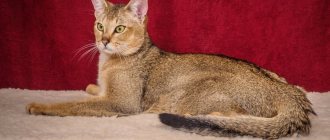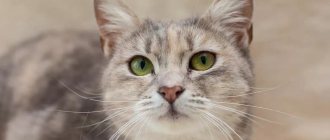Siam is the old name for Thailand. It is from this country that beautiful blue-eyed cats with a special disposition come. The Siamese breed is over five hundred years old. Over many centuries, a stable, specific appearance has developed: light fur on the body combined with dark paws, ears, tail and a mask on the face.
American breeders have changed the silhouette of Siamese cats, making it lighter and more slender, but their character, shaped by centuries of selection, is still determined by pronounced intelligence and high sociality.
Siamese breed and character
Animal psychologists identify certain traits that are inherent in the breed and from which one can determine the degree of nervous excitability or its absence:
- A light bone structure and graceful asthenic physique indicate a possible tendency to uncontrollable expression of emotions.
- A massive chest and a denser physique indicate melancholy and calmness in the behavior of the animal.
- Long hair and light color indicate the calm nature of the cat.
- Short-haired individuals with dark-colored fur and spots are more independent, selfish, jealous, and have a vindictive disposition.
Siamese cats prefer company, are attached to people and love to be near them. By temperament they are choleric, and this quality given from birth cannot be changed. This is why Siamese of any age are bouncy, active and spontaneous, and love to openly express their emotions.
Cats show any feelings, be it sympathy, resentment or affection, clearly and directly. They are playful, curious, love to seek attention and explore new places and things.
Cat cleanliness
Pets can take care of themselves; you need to periodically check their condition and, if necessary, help the cat take care of itself.
Necessary:
- check the cleanliness of the ears; they need to be wiped once every 7 days with a specialized ear cleaner;
- Teeth should be brushed every month to prevent tartar or other diseases from appearing;
- You need to remove dried crusts from your eyes with cotton pads.
Cats do not like to bathe; if you need to bathe them, this is done no more than once every 4 months.
During shedding, the animal needs to be combed twice a week, and on normal days it is enough to run a wet palm from the withers to the tail to remove excess hair.
Causes of aggression
Siamese cats love to vocalize if they don't like something. Often this behavior is perceived as aggression, but in fact it only expresses their disagreement with external circumstances.
Important! A loud voice is not a sign of anger or deceit, but only emphasizes the independence of the animal and its right to its own opinion.
The reasons for the aggressive behavior of Siamese cats are associated with their origin:
- There is a legend according to which a feature of ancient Siamese and Bengal cats was an uneven tail, with pronounced knots and creases. This anomaly was a disorder in the structure of the bones and was characterized by various diseases of the joints and spine. Therefore, any attempts to pet such a cat caused her unbearable pain and caused justified anger, which was preserved in the form of an unconscious instinct.
- The presence of a special genetic disease, convergent strabismus, causes Siamese to have difficulty distinguishing objects. Therefore, any rapidly approaching object causes an aggressive reaction in him in the form of attack or defense.
Behavior correction
If you create the necessary living conditions for a Siamese cat and surround him with affection and tenderness, this affectionate and friendly animal will answer you in kind.
Any cruelty on the part of a person, which the kitten remembers in childhood, can leave a negative imprint on the psyche of the cat, which will not forget the incident even as an adult and will be afraid of people.
If you do observe signs of dissatisfaction in your Siamese, in this case you need to adhere to the following rules:
- Be more attentive if your pet is nervous, scratching furniture, or showing other signs of destructive behavior.
- Provide reasonable alternatives, such as a tray instead of a flower pot and a scratching post as a substitute for scratching the sofa and wallpaper.
- Adhere to the chosen training model and prohibitions to consolidate skills. Siamese cats are highly trainable and can be trained if treated consistently.
- Do not hit the cat or scold him in a raised tone, otherwise she will not change her behavior, but will do forbidden things in the absence of her owners.
The opinion that Siamese cats are aggressive and evil is unfairly associated with their breed. External similarities make it possible to confuse Siamese and Thai cats; the latter are not as loyal and more self-sufficient, but not vindictive, and do not have mental problems in the form of outright aggression towards humans.
Correcting the behavior of a Siamese cat both in childhood and in adulthood can help your pet get rid of destructive manifestations of character through consistent actions, excluding aggression towards him.
Source
Predatory cats
Representatives of cats are predators. Signs of aggression are most often caused by pain, fear, or fighting for territory. Character traits are also an important factor in the manifestation of bitterness.
jungle cat
This is an undomesticated breed that is unlikely to become an obedient pet. But despite their character, people still like these animals for:
- ears with tassels;
- beautiful color.
Exotic lovers try to tame such cats, but they are extremely rarely trainable . Most often, animals remain predators. Representatives of this breed require a lot of attention and constantly need communication with their owner. Receiving a daily dose of affection and care from the owner, the pets will be in a good mood.
They are very playful and are constantly on the move. They love to hunt and climb. They absolutely cannot sit on their hands for a long time.
They react relatively calmly to other pets, but you need to make sure that jungle cats do not try to hunt them. They don’t really like affection and often try to attack everyone and everything.
This breed reacts to any sounds and even the slightest rustle will interest them. Unlike other cats, these animals love to swim and enjoy splashing in the water.
Wild manul
This breed is extremely charming and you just want to cuddle them. But in fact, these cats are very dangerous and difficult to tame . They are quite independent and have fangs three times larger than other cats. Outwardly they look a little like a lynx. They can reach 65 centimeters in length and weight does not exceed 5 kilograms.
It is impossible to tame the Pallas's cat. They have an extremely complex and gloomy character. They will never become affectionate or friendly. They will not even show kindness to a person who feeds a representative of this breed. Pallas' cats love to hide and attack unexpectedly.
Owners thoughtlessly get such an animal for themselves, and then hand it over to the zoo, because they cannot tolerate the housekeeping created by the Pallas's cat in the house. The cat avoids the person in every possible way and can easily bite or scratch. Attempts at training do not have any effect: this breed will tear and mark everything around.











